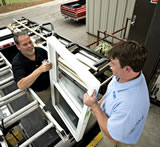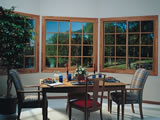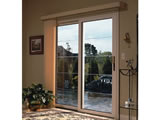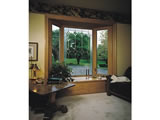New Windows in Durham
Looking for New Windows in Durham? There are many decisions to be made in choosing replacement windows, including which manufacturer, which type of window and which features you need. The guys at "My Guys Remodeling" can guide you through all the decisions and help you make the right choice for your home and budget.
Durham City Statistics
Durham is a city in the U.S. state of North Carolina. It is the county seat of Durham County and also extends into Wake county. It is the fifth largest city in the state by population, with 217,847 residents as of July 1, 2007. It is the home of Duke University and North Carolina Central University, and is also one of the vertices of the Research Triangle area (home of the Research Triangle Park).
Durham is the core of the four-county Durham, NC MSA, which has a population of 479,624 as of July 1, 2007. The US Office of Management and Budget also includes Durham as a part of the Raleigh-Durham-Cary Combined Statistical Area, which has a population of 1,635,974 as of July 1, 2007.
Durham originated in 1853 with the search for a suitable railroad depot for the North Carolina Railroad between Raleigh and Hillsborough. The wood-burning steam locomotives of the time had to stop frequently to refuel, and depots supplying wood and water could not be more than 25–30 miles apart.
A post office known as Herndon's existed in the area from 1827, and another at nearby Prattsburg was established in 1836. The landowners at Prattsburg refused to sell land to the railroad. Somewhat further to the northwest in what was then part of Orange County, a country physician named Bartlett S. Durham lived and practiced along the route. He donated land to the railroad, which named the subsequent depot Durham Station. Prior to the arrival of the railroad, the area now known as Durham was almost entirely agricultural, with a few businesses catering to travelers (particularly livestock drivers) along the Hillsborough Road. This road, eventually followed by US Route 70, was the major east-west route in North Carolina from colonial times until the construction of interstate highways.
The community of Durham Station grew slowly before the Civil War, but expanded rapidly following the war; the present city charter dates from 1869. Much of this growth can be attributed to the establishment of a thriving tobacco industry. Soldiers, both Union and Confederate, were encamped near Bennett Place, just outside Durham Station, during surrender proceedings in April 1865. While on the battlefront, soldiers liberally helped themselves to the area's Brightleaf Tobacco, which purportedly had a milder flavor than other tobacco varieties. Veterans returned home after the war with an interest in acquiring more of the great tobacco they had sampled in North Carolina. Numerous orders were mailed to Green's tobacco company requesting more of the Durham tobacco. W.T. Blackwell partnered with Green and renamed the company as the "Bull Durham Tobacco Company". The name "Bull Durham" is said to have been taken from the bull on the British Colman's Mustard, which Mr. Blackwell (mistakenly) believed was manufactured in Durham, England.
20th century
Looking west along Parrish Street, toward CCB (SunTrust) Building
The rapid growth and prosperity of the Bull Durham Tobacco Company, and Washington Duke's Duke & Sons Tobacco Company, resulted in the rapid growth of the city of Durham. While the tobacco industry dominated the city's economy initially, it was soon rivaled by the establishment of multiple textile mills, particularly in East and West Durham. Much of the early city architecture, both commercial and residential, dates from the period of 1890 - 1930.
Durham quickly developed a vibrant Black community, the center of which was an area known as 'Hayti' (pronounced HAY-tie), just south of the center of town, where some of the most prominent and successful black-owned businesses in the country during the early 20th century were established. These businesses — the best known of which are North Carolina Mutual Insurance Company and Mechanics & Farmers' Bank — were centered on Parrish St., which would come to be known as "Black Wall Street."
In 1924 James Buchanan Duke established a philanthropic foundation in honor of his father Washington Duke to support Trinity College in Durham. The college changed its name to Duke University and built a large campus and hospital a mile west of Trinity College (the original site of Trinity College is now known as the Duke East Campus).
Durham's manufacturing fortunes declined during the mid-20th century. Textile mills began to close during the 1930s. Competition from other tobacco companies (as well as a decrease in smoking after the 1960s) reduced revenues from Durham's tobacco industry. Although the region benefited significantly from the establishment of Research Triangle Park in 1958, Durham did not experience the same early increases in housing development as neighboring Raleigh and Cary. Suburban flight also contributed to the slow but progressive decline of downtown Durham as a retail and economic center.
With a strong African-American community, a strong Civil Rights movement developed in Durham. Multiple sit-ins were held, and Dr. Martin Luther King Jr. visited the city during the struggle for equal rights. This strong community was not enough to prevent the demolition of portions of the Hayti district for the construction of the Durham Freeway during the late 1960s. The freeway construction resulted in losses to other historic neighborhoods, including Morehead Hills, West End, and West Durham. Combined with large-scale demolition using Urban Renewal funds, Durham suffered significant losses to its historic architectural base.
Five Points in downtown Durham
Durham's growth began to rekindle during the 1970s and 1980s, with the construction of multiple housing developments in the southern part of the city, nearest Research Triangle Park, and the beginnings of downtown revitalization. In 1975, the St. Joseph's Historical Foundation at the Hayti Heritage Center was incorporated to "preserve the heritage of the old Hayti community, and to promote the understanding of and appreciation for the African American experience and African Americans' contributions to world culture." A new downtown baseball stadium was constructed for the Durham Bulls in 1994. A large-scale renovation of the historic American Tobacco Company (formerly Bull Durham) complex commenced in 2003.
Major employers in Durham are Duke University (39,000 employees, 13,000 students), about 2 miles west of the original downtown area, and companies in the Research Triangle Park (49,000 employees), about 10 miles southeast. These centers are connected by the Durham Freeway (NC 147).














